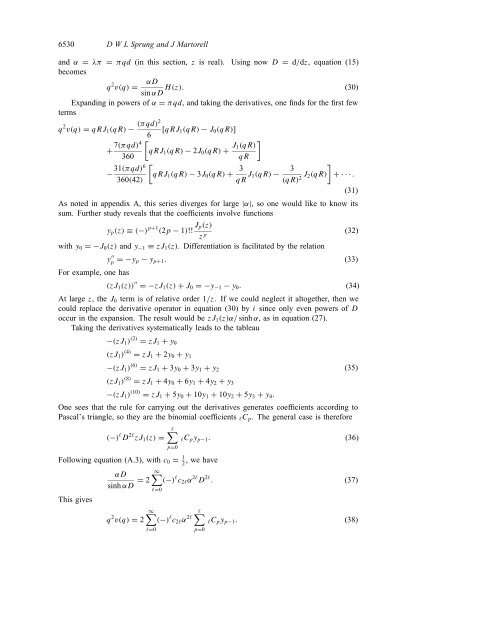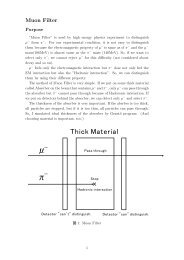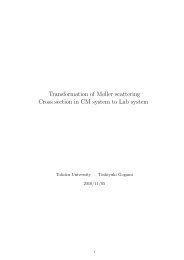The symmetrized Fermi function and its transforms
The symmetrized Fermi function and its transforms
The symmetrized Fermi function and its transforms
Create successful ePaper yourself
Turn your PDF publications into a flip-book with our unique Google optimized e-Paper software.
6530 D W L Sprung <strong>and</strong> J Martorell<br />
<strong>and</strong> α = λπ = πqd (in this section, z is real). Using now D = d/dz, equation (15)<br />
becomes<br />
q 2 v(q) =<br />
αD H(z). (30)<br />
sin αD<br />
Exp<strong>and</strong>ing in powers of α = πqd, <strong>and</strong> taking the derivatives, one finds for the first few<br />
terms<br />
q 2 v(q) = qRJ 1 (qR) − (πqd)2 [qRJ 1 (qR) − J 0 (qR)]<br />
6<br />
[<br />
+ 7(πqd)4 qRJ 1 (qR) − 2J 0 (qR) + J ]<br />
1(qR)<br />
360<br />
qR<br />
− 31(πqd)6<br />
360(42)<br />
[<br />
qRJ 1 (qR) − 3J 0 (qR) + 3<br />
qR J 1(qR) − 3<br />
(qR) 2 J 2(qR)<br />
]<br />
+···.<br />
(31)<br />
As noted in appendix A, this series diverges for large |α|, so one would like to know <strong>its</strong><br />
sum. Further study reveals that the coefficients involve <strong>function</strong>s<br />
y p (z) ≡ (−) p+1 (2p − 1)!! J p(z)<br />
(32)<br />
z p<br />
with y 0 =−J 0 (z) <strong>and</strong> y −1 ≡ zJ 1 (z). Differentiation is facilitated by the relation<br />
y p ′′ =−y p−y p+1 . (33)<br />
For example, one has<br />
(zJ 1 (z)) ′′ =−zJ 1 (z) + J 0 =−y −1 −y 0 . (34)<br />
At large z, the J 0 term is of relative order 1/z. If we could neglect it altogether, then we<br />
could replace the derivative operator in equation (30) by i since only even powers of D<br />
occur in the expansion. <strong>The</strong> result would be zJ 1 (z)α/ sinh α, as in equation (27).<br />
Taking the derivatives systematically leads to the tableau<br />
−(zJ 1 ) (2) = zJ 1 + y 0<br />
(zJ 1 ) (4) = zJ 1 + 2y 0 + y 1<br />
−(zJ 1 ) (6) = zJ 1 + 3y 0 + 3y 1 + y 2<br />
(35)<br />
(zJ 1 ) (8) = zJ 1 + 4y 0 + 6y 1 + 4y 2 + y 3<br />
−(zJ 1 ) (10) = zJ 1 + 5y 0 + 10y 1 + 10y 2 + 5y 3 + y 4 .<br />
One sees that the rule for carrying out the derivatives generates coefficients according to<br />
Pascal’s triangle, so they are the binomial coefficients l C p . <strong>The</strong> general case is therefore<br />
l∑<br />
(−) l D 2l zJ 1 (z) = lC p y p−1 . (36)<br />
p=0<br />
Following equation (A.3), with c 0 = 1 , we have<br />
2<br />
αD<br />
∞∑<br />
sinh αD = 2 (−) l c 2l α 2l D 2l . (37)<br />
l=0<br />
This gives<br />
∞∑<br />
l∑<br />
q 2 v(q) = 2 (−) l c 2l α 2l<br />
lC p y p−1 . (38)<br />
l=0<br />
p=0









